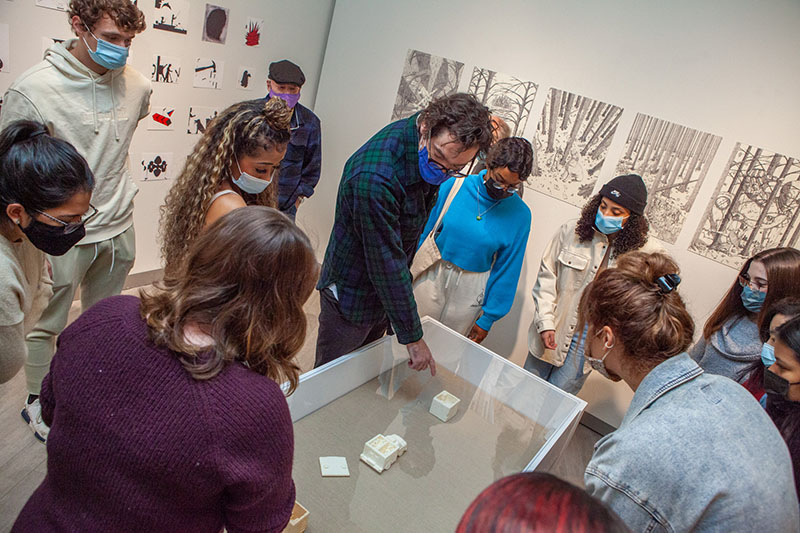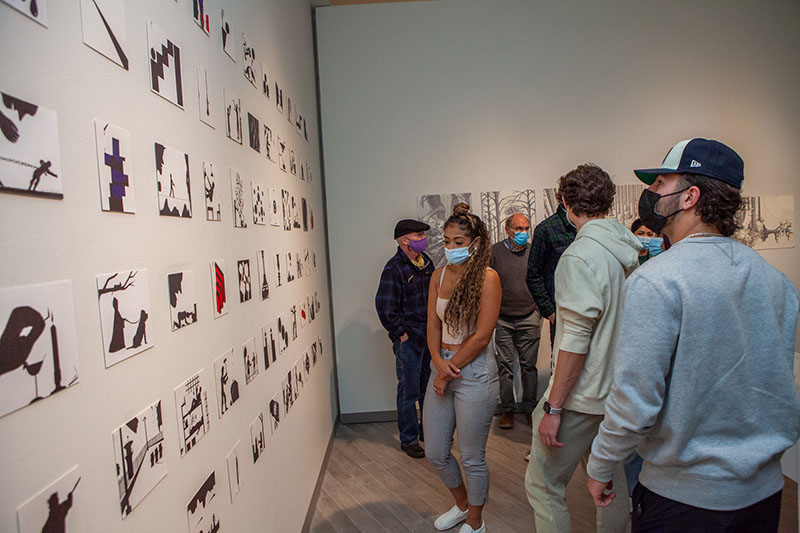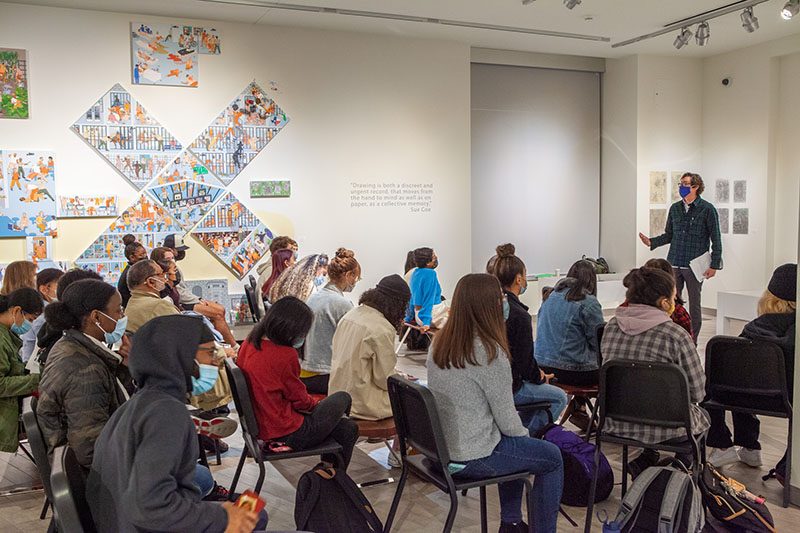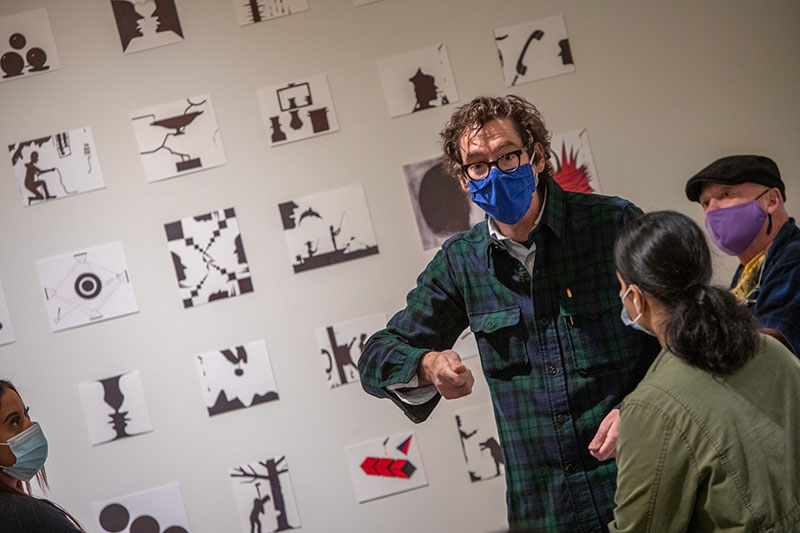- Apply
- Visit
- Request Info
- Give
Art Gallery showcases prison artwork
'The Artist as Witness' runs until February
Written by Dwight Bachman
Published on October 26, 2021
On Oct. 18, Eastern’s Art Gallery, in collaboration with the Connecticut Prison Arts program, opened the exhibition “The Artist as Witness.” The exhibition runs through Feb. 1, 2022. An opening reception took place on Oct. 19, featuring exhibition curator Jeffrey Greene, manager of the Prison Art Program.
Initiated in 1978, the program advocates for the arts and artists within Connecticut’s correctional institutions and the State’s criminal justice system. It’s website says the program “works within the Connecticut Department of Corrections (DOC) to make a positive difference in the lives of inmates. The program hopes to encourage participants’ self-confidence, self-esteem, work ethic, empathy, critical thinking, technical skill and their connection to the outside community and loved ones.”
“This difference is visible and tangible,” said Greene. “Most often, this difference — a change in direction, attitude, possibility, understanding and environment — is witnessed within the world of prison itself.”
“Our group of artists challenge us with their profound engagement,” said Julia Wintner, coordinator of gallery and museum services. “Their witness is rendered in meticulous figuration, the emotions conveyed are raw — empathy, compassion and outrage. They render solid proof of unjust events so that they become impossible to ignore.”
Art, combined with faith, served as a miracle worker for artist inmate Jamaar Quarles: “You are a person of courage and strength. Nothing can take that away. You are kindness and warmth with uncounted gifts yet to give up. Whatever life may bring, please believe in these two things — you are stronger than you imagine, and you are never alone.”
“Thank you, Prison Arts Program,” said artist inmate John Foran. “My day job is # 347839. But the real me is a man of peace, and of reason — an eye of an artist, the soul of a poet and the heart of a warrior.”
“With art, there are no walls or doors, just anticipation, destination and instinctive zones,” said artist inmate Michael Reddick. “My only dream is to be a part of life, full and rich!”
“For many of the inmates, this (art) connection belies the difference between just doing time or finding a way out of a life of crime and hardship,” said Doug Kulmarz, director of volunteer and recreational services for the (DOC). “The artwork is fresh and new, and we know it’s been delivered by a caring and dedicated program.”
Sociology and Criminology Professor Theresa Severance sent her class in Justice Alternatives and the Arts to Greene’s lecture in the gallery. “We investigate the application of the arts to populations affected by the criminal justice system, including currently imprisoned individuals, those re-entering our community from prison, children and families affected by incarceration, victims of crime and at-risk youth. We explore how the arts are used in these contexts, the challenges of using art in these settings and the outcomes of arts-based programs. I’m challenging them to see these populations in a different light.”
Eastern students were impressed with the high quality of the work produced by the inmates, dreams confined in cells and prison blocks. “The presentation on Prison Arts was thought-provoking,” said Victoria Cirilo ’22, a Psychology major from Manchester with a concentration in Mental Health Counseling. “Jeffrey Greene described that the goal is to bring humanity into the prisons; what better way to do that than through art? Art brings people together regardless of the artist’s background. Had there not been names, there would be no indication that the creators were incarcerated. It was moving to see the different perspectives that each individual artist had through their mediums and humbling to see the stories depicted in their works.”
Owen Dagata ’22, a Criminology major from Willington, agreed: “The talk was very eye-opening, seeing how the arts program pushes the inmates to do more things with their time and to open their mind to create things that represent the world around them. They take that skill into the real world and still enjoy making it a passion upon release. Mr. Greene, from his perspective of a witness, raised a good point — that at the end of the day, they (the inmates) are human beings and need things to keep them going.”
“I thought the presentation was very well put together,” said Domenic Scarano ’23, a Criminology major from Berlin. “I was not expecting this level of hands-on artwork to come out of a prison program. Also, the story behind the work of each artist conveyed a different story and different message. As a criminology major, this was a really enjoyable learning experience.”
Severance said she and her students have also partnered with the Community Partners in Action Prison Arts Program to facilitate dialogue between her students and Greene's incarcerated students, to participate in The Big Read, the visual partner to exhibition. The Big Read is a program funded by the NEA to encourage the campus and local communities to read the graphic novel, “The Best We Could Do,” by Vietnamese American writer Thi Bui. Students in Severance’s class developed a list of questions for Greene’s inmate students, and his students did the same for her students.
Wintner said the exhibition reveals that “arts experiences develop and foster positive, constructive and meaningful living in prison, and that over time, participants develop remarkable technical skill, while also developing the ability to consider their work and themselves, and their relationships to others and the world. As a result, participating artists become exponentially less likely to return to prison upon release. The Artist as Witness brings us face to face with the political moment. This exhibition is our modest contribution to the ubiquitous and necessary attention in today’s art world, to social injustice. It is an integral part of Eastern’s role as a public gallery serving the campus and neighboring communities.”
The Art Gallery is located in the Fine Arts Instructional Center and is open Monday–Friday from 9 a.m.–6 p.m. and weekends by appointment. For more information, contact wintnerj@easternct.edu or visit www.easternct.edu/art-gallery.





